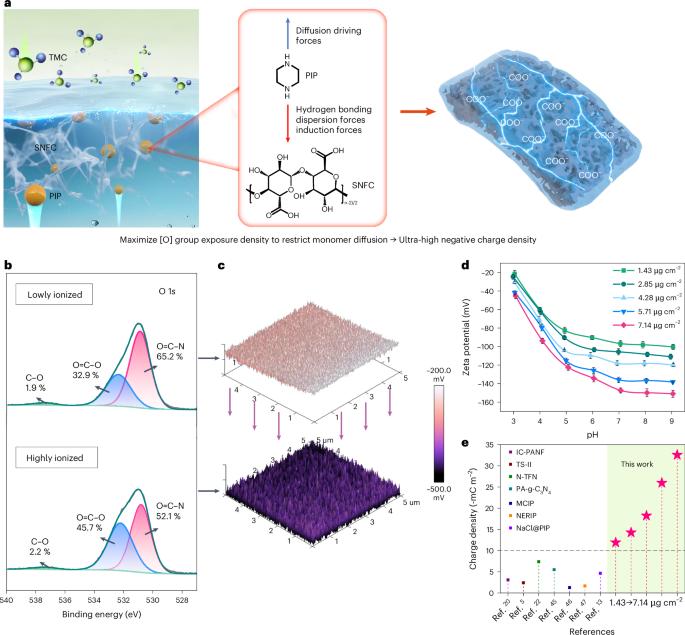Nanofiltration membranes with ultra-high negative charge density for enhanced anion sieving and removal of organic micropollutants
IF 24.1
引用次数: 0
Abstract
Nanofiltration membranes with high charge density are highly attractive for selectively removing organic micropollutants and divalent anions from water environments. Here we constructed polyamide (PA) membranes with ultra-high negative charge density via a sea-squirt nanofibrillated cellulose restricted interfacial polymerization process. Sea-squirt nanofibrillated cellulose, which contains a high content of 7.0% carboxyl groups and 29.8% hydroxyl groups, effectively fettered piperazine and regulated the interfacial polymerization reaction kinetics. As a result, the optimized membrane had an ultra-high zeta potential of −148 mV at pH 7 and a charge density of −32.6 mC m−2. This membrane achieved outstanding performance metrics, including a water permeance of 41.5 l m−2 h−1 bar−1, exceptional SO42−/Cl− selectivity of 144.5 and greatly increased water/organic micropollutant selectivity. Molecular dynamics simulations revealed a 73.1% reduction in the diffusion rate of piperazine due to competitive forces, leading to a PA surface enriched with -COOH groups. This work provides an effective strategy for tuning the PA membrane charge density to increase water purification and wastewater treatment efficiency. Polyamide membranes with ultra-high negative charge density demonstrate exceptional removal of divalent ions and organic pollutants without compromising water permeance.

纳滤膜具有超高负电荷密度,用于增强阴离子筛选和去除有机微污染物
具有高电荷密度的纳滤膜在选择性去除水环境中的有机微污染物和二价阴离子方面具有很高的吸引力。本文采用海鞘纳米纤化纤维素限制界面聚合工艺,构建了具有超高负电荷密度的聚酰胺(PA)膜。海鞘纳米纤化纤维素含有7.0%的羧基和29.8%的羟基,可以有效地束缚哌嗪并调节界面聚合反应动力学。结果表明,优化后的膜在pH为7时具有- 148 mV的超高zeta电位和- 32.6 mC m−2的电荷密度。该膜取得了优异的性能指标,包括41.5 l m−2 h−1 bar−1的透水性,144.5的SO42−/Cl−选择性,以及大大提高了水/有机微污染物的选择性。分子动力学模拟表明,由于竞争作用力,哌嗪的扩散速率降低了73.1%,导致PA表面富集了-COOH基团。本研究为调整PA膜电荷密度以提高水净化和废水处理效率提供了一种有效的策略。具有超高负电荷密度的聚酰胺膜表现出非凡的去除二价离子和有机污染物而不影响水渗透。
本文章由计算机程序翻译,如有差异,请以英文原文为准。
求助全文
约1分钟内获得全文
求助全文

 求助内容:
求助内容: 应助结果提醒方式:
应助结果提醒方式:


